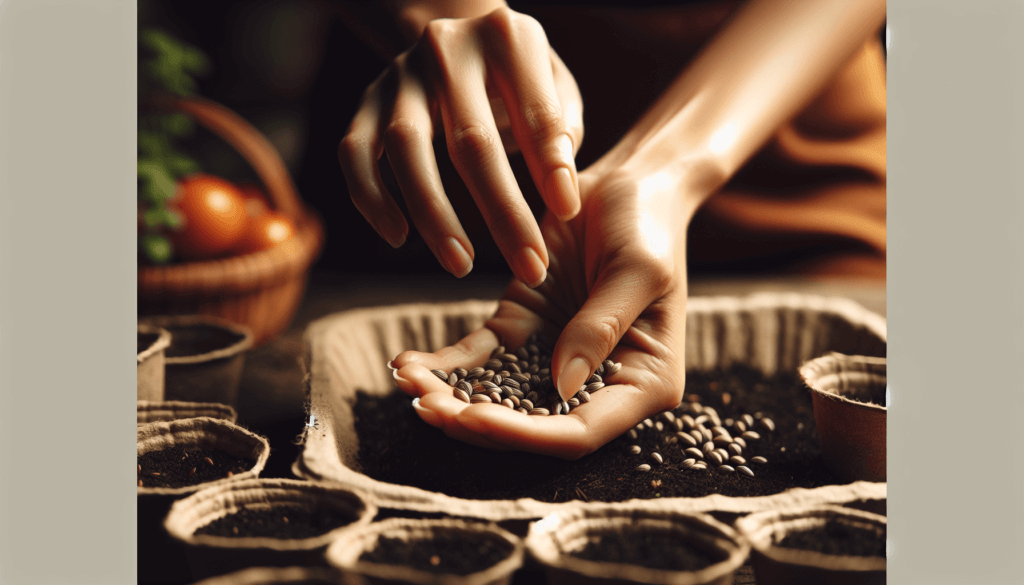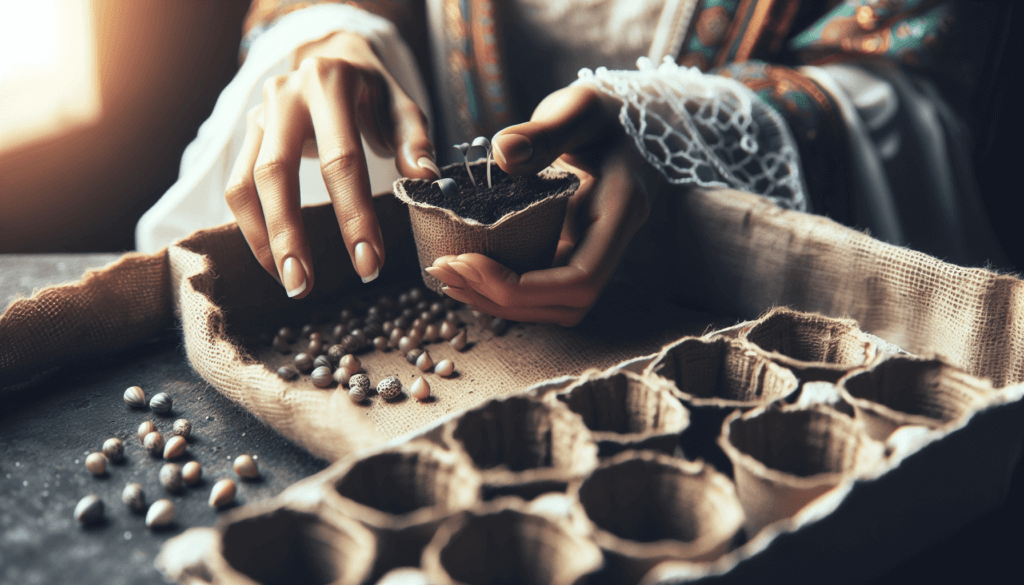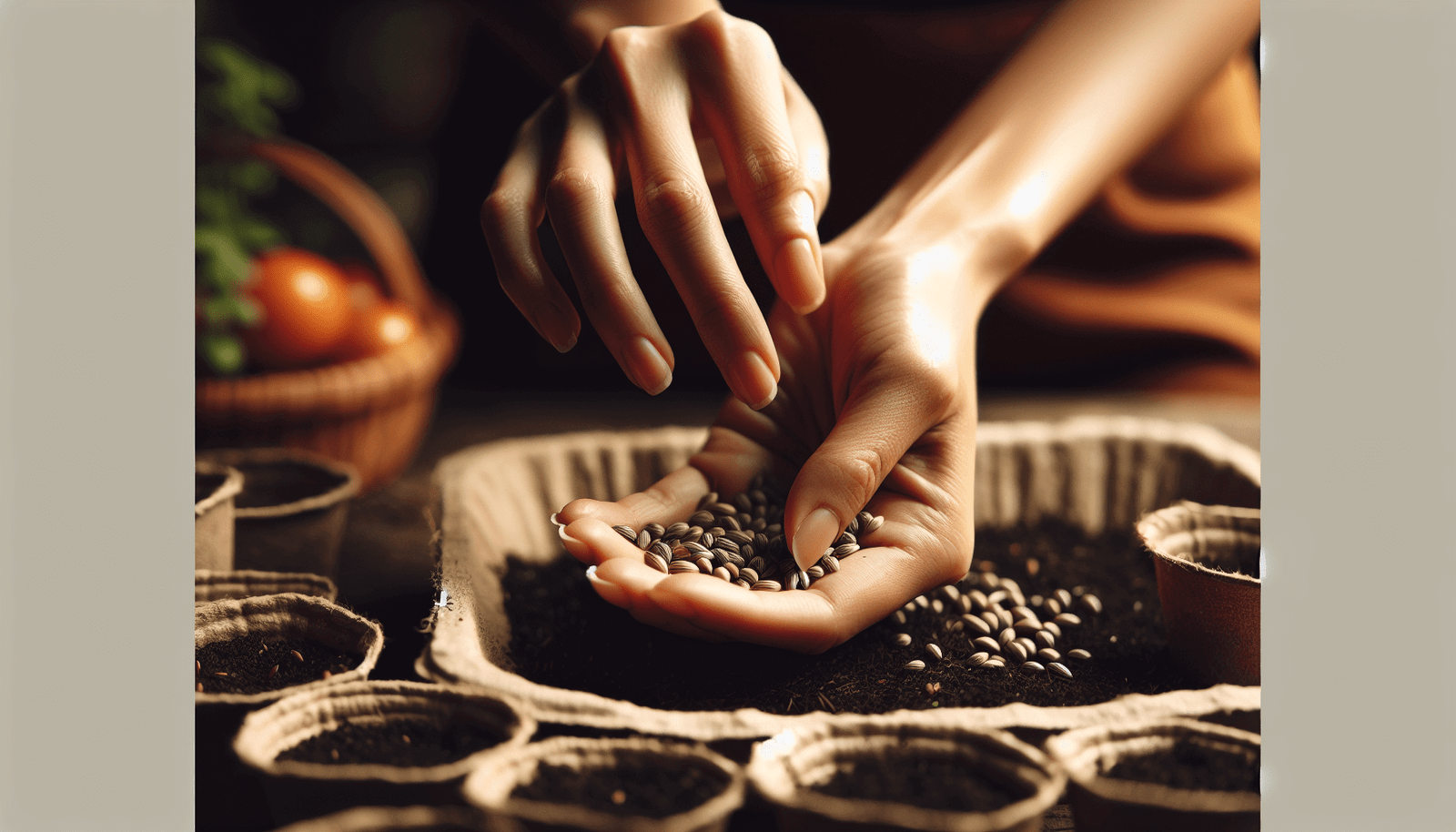Are you ready to embark on a sustainable gardening journey? From novice gardeners to seasoned horticulturists, everyone can benefit from the knowledge of sustainable practices for seed starting. This article will guide you through various techniques that can help minimize your environmental impact while ensuring the success of your seeds. Whether you’re interested in reducing waste, conserving water, or promoting biodiversity, this article has got you covered. Get ready to nurture nature and grow your seeds in an eco-friendly way.
Choosing sustainable seed starting materials
Using biodegradable seed pots
When starting your seeds, it’s important to choose containers that are environmentally friendly. Biodegradable seed pots are an excellent choice as they are designed to break down naturally over time. These pots are usually made from materials such as coconut coir, peat, or bioplastics that are derived from renewable resources. By using biodegradable seed pots, you can avoid contributing to plastic waste and provide a healthier growing environment for your seedlings.
Opting for organic seeds
Another way to make your seed starting process more sustainable is by opting for organic seeds. Organic seeds are grown without the use of synthetic pesticides or fertilizers, which can be harmful to the environment and human health. By choosing organic seeds, you are supporting sustainable farming practices and reducing the impact of conventional agriculture on ecosystems. Look for seeds certified by reputable organic certifiers to ensure their authenticity.
Selecting sustainable potting mixes
When it comes to choosing the right potting mix for your seeds, it’s important to select sustainable options. Many commercial potting mixes contain synthetic chemicals and peat, which is often harvested from ecologically sensitive wetlands. Instead, consider using sustainable alternatives such as coconut coir, compost, or locally sourced organic materials. These options not only provide a nutrient-rich medium for seed germination but also help reduce the demand for unsustainable practices.
Implementing eco-friendly seed starting techniques
Direct sowing
Direct sowing is an eco-friendly seed starting technique that eliminates the need for seed pots altogether. By sowing your seeds directly into the ground or containers outside, you avoid the use of plastic pots and reduce the risk of transplant shock. Direct sowing is particularly suitable for larger seeds or plants that have a high tolerance for direct sunlight and outdoor growing conditions. Remember to consider the specific requirements of each plant and provide the necessary care during the germination process.
Using recycled materials for seed trays
If you prefer to use seed trays for your seed starting, consider using recycled materials instead of purchasing new ones. Repurposed household items such as egg cartons, yogurt containers, or newspaper pots can make excellent seed trays. Not only do these materials keep waste out of the landfill, but they also provide a cost-effective alternative to traditional seed trays. Just make sure to create drainage holes in the bottom of the containers to prevent waterlogging.
Creating homemade seed starting mix
Another eco-friendly seed starting technique is to create your own seed starting mix. By making your own mix, you have control over the ingredients and can ensure that they are sustainable. A basic recipe for homemade seed starting mix includes a combination of compost, coconut coir, vermiculite or perlite, and organic fertilizer. This mix provides a balanced blend of nutrients, moisture retention, and aeration for optimal seedling growth. Experiment with different ratios and ingredients to find the mix that works best for your plants.
Utilizing natural pest control methods
When starting seeds, it’s important to protect them from pests without resorting to chemical pesticides. There are several natural pest control methods you can implement to keep your seedlings safe. For example, companion planting can help deter pests by placing plants that repel insects next to your seedlings. You can also use homemade insecticidal soaps made from natural ingredients such as neem oil or garlic. Additionally, attracting beneficial insects to your garden, such as ladybugs or lacewings, can help control pests naturally.

Conserving resources in seed starting
Water conservation
Conserving water is an important aspect of sustainable seed starting. One way to minimize water usage is by utilizing bottom watering techniques. Instead of watering from the top, place your seed trays in a container with water and allow the soil to absorb it from the bottom. This prevents water waste through evaporation and encourages stronger root development. Additionally, consider collecting rainwater for watering your seedlings, which is both cost-effective and sustainable.
Energy-efficient lighting
If you’re starting seeds indoors or in a greenhouse, it’s essential to choose energy-efficient lighting options. LED grow lights are a sustainable choice as they consume less energy compared to traditional fluorescent or incandescent lights. LED lights also produce less heat, reducing the risk of overheating your seedlings. Opt for full-spectrum grow lights that mimic natural sunlight to provide the necessary light intensity and spectrum for robust seedling growth.
Reducing waste in seedling care
When caring for your seedlings, it’s important to minimize waste as much as possible. One way to do this is by using organic mulch to suppress weed growth and retain moisture, reducing the need for excessive watering. Additionally, consider reusing or repurposing materials such as plant markers, seed trays, and greenhouse covers for future seed starting projects. By reducing waste, you minimize your environmental impact and create a more sustainable seed starting practice.
Promoting biodiversity in seed starting
Choosing heirloom and open-pollinated seeds
When selecting seeds for your seed starting, prioritize heirloom and open-pollinated varieties. Heirloom seeds are varieties that have been passed down through generations, while open-pollinated seeds are pollinated naturally by wind, insects, or birds. Both types of seeds promote biodiversity as they preserve genetic diversity and adaptability in plants. By growing heirloom and open-pollinated seeds, you contribute to the conservation of unique and traditional plant varieties.
Supporting native plant species
Another way to promote biodiversity in seed starting is by supporting native plant species. Native plants have evolved to thrive in local ecosystems and provide essential habitats for native wildlife. By incorporating native plant species in your seed starting, you contribute to the preservation of local biodiversity and support the health of your surrounding environment. Research and select native plant species that are suitable for your region and garden conditions for optimal success.
Avoiding genetically modified organisms (GMOs)
Genetically modified organisms (GMOs) are plants whose genetic material has been altered in a laboratory. These plants are often engineered to withstand harsh conditions or resist pests, but they can have adverse effects on ecosystems and human health. When starting seeds, it’s important to avoid using GMO seeds to promote sustainable seed starting practices. Look for seeds that are labeled non-GMO or organic to ensure that they have not been genetically modified.

Implementing sustainable seedling care
Proper watering techniques
Proper watering techniques are crucial for sustainable seedling care. Overwatering can lead to root rot and fungal diseases, while underwatering can stunt seedling growth. The key is to maintain consistent soil moisture without waterlogging the roots. Check the moisture level regularly by inserting your finger into the soil, and water only when the top inch feels dry. Water slowly and deeply to encourage deep root development and avoid wasteful runoff.
Using natural and organic fertilizers
To provide essential nutrients for your seedlings, opt for natural and organic fertilizers instead of synthetic ones. Natural fertilizers such as compost, worm castings, or well-rotted manure enrich the soil with organic matter and beneficial microorganisms. Organic fertilizers derived from plant or animal sources provide a slow-release of nutrients, promoting steady and healthy seedling growth. Avoid chemical fertilizers that can negatively impact soil quality and water systems.
Encouraging strong and resilient seedlings
To produce strong and resilient seedlings, it’s important to provide them with optimal growing conditions. Ensure that your seedlings receive adequate light, air circulation, and proper spacing to prevent overcrowding and promote strong stem development. Thin out weaker seedlings to give the stronger ones more room to grow. Additionally, gently brush your hand over the seedlings once a day to simulate natural wind and encourage sturdy stem growth.
Reducing environmental impact in seed starting
Minimizing use of single-use plastics
One of the major concerns in modern gardening practices is the excessive use of single-use plastics. To reduce your environmental impact, minimize the use of plastic trays, pots, and covers. Opt for reusable alternatives such as biodegradable seed pots, recycled materials, or even fabric pots. By choosing sustainable materials and reducing your reliance on single-use plastics, you contribute to a healthier ecosystem and reduce waste in landfills.
Composting plant waste
Seed starting inevitably leads to the generation of plant waste, such as pruned seedlings or discarded plant matter. Instead of throwing them in the trash, consider composting these materials. Composting not only reduces waste but also creates nutrient-rich compost that can be used to improve soil fertility in your garden. Set up a composting system in your backyard or find a community composting facility to ensure that plant waste is diverted from landfills.
Reusing seed starting materials
To further reduce waste and promote sustainability, make a conscious effort to reuse seed starting materials. Wash and sterilize seed trays, pots, and tools after each use to prevent the spread of pathogens. Keep track of your seed starting supplies and store them properly for future use. By reusing materials instead of buying new ones each year, you save money and reduce the demand for resource-intensive production processes.

Encouraging pollinator-friendly seed starting
Growing plants that attract pollinators
Pollinators such as bees, butterflies, and hummingbirds play a crucial role in plant reproduction and ecosystem health. When starting seeds, consider growing plants that attract pollinators and provide them with nectar and pollen sources. Choose flowers with bright colors, pleasant aromas, and different bloom times to attract a wide variety of pollinators. By creating a pollinator-friendly garden, you support biodiversity and ensure the successful pollination of your plants.
Avoiding pesticide use
To protect pollinators and other beneficial insects, it’s important to avoid the use of chemical pesticides in your seed starting process. Pesticides can be harmful to bees, butterflies, and other pollinators, causing declines in their populations. Instead, focus on preventive measures such as companion planting, natural pest control methods, and creating a balanced ecosystem that attracts beneficial insects. By avoiding pesticide use, you contribute to a healthier and more sustainable environment for pollinators.
Providing nesting habitats for pollinators
Another way to support pollinators in your seed starting is by providing them with nesting habitats. Many native bees and solitary wasps require suitable nesting sites to lay their eggs and raise their young. Incorporate features such as bee houses, nesting blocks, or undisturbed areas of soil in your garden to create nesting opportunities. By providing safe and suitable habitats, you encourage pollinators to establish themselves in your garden and contribute to pollination.
Participating in seed sharing and conservation
Joining seed exchange programs
Seed exchange programs are a great way to connect with other gardeners, preserve heirloom varieties, and support sustainable seed starting practices. Join local seed exchanges, community gardens, or online forums where gardeners share their seeds and knowledge. Participating in seed exchanges not only allows you to access a wide range of unique seeds but also contributes to the conservation of diverse plant genetic resources.
Saving and storing seeds for future use
Saving and storing seeds from your own plants is a sustainable practice that allows you to become self-sufficient and reduce dependence on commercial seed suppliers. Collect seeds from open-pollinated or heirloom plants that have successfully grown in your garden. Properly dry and store them in a cool, dark, and dry place to maintain their viability. Label each seed packet with the plant’s name, variety, and the year it was harvested for easy identification.
Supporting local seed banks and organizations
Supporting local seed banks and organizations dedicated to seed conservation is an important step in promoting sustainable seed starting. Seed banks collect, store, and distribute seeds to preserve genetic diversity and ensure access to rare or endangered plant varieties. By donating to or purchasing seeds from these organizations, you contribute to their conservation efforts and help maintain a diverse and resilient seed supply.

Educating and spreading awareness
Sharing knowledge with others
One of the most effective ways to promote sustainable seed starting is by sharing your knowledge and experience with others. Talk to your friends, family, and community about the importance of sustainable gardening practices. Share tips and tricks for seed starting, discuss the benefits of organic seeds, and encourage others to adopt eco-friendly techniques. By sharing your expertise, you can inspire others to take action and make a positive impact on the environment.
Organizing workshops and events
Organizing workshops and events focused on sustainable seed starting can be a powerful way to educate and engage people in your community. Offer hands-on demonstrations on topics such as seed saving, creating homemade seed starting mixes, or natural pest control methods. Host seed swaps or seedling sales to promote local seed sharing and conservation. By bringing people together and providing practical knowledge, you empower others to become stewards of sustainability in their own gardens.
Promoting sustainable seed starting practices
Utilize online platforms, social media, or local newsletters to promote sustainable seed starting practices. Write blog articles, create informative videos, or share inspiring stories of successful sustainable seed starting. Encourage others to join in by using hashtags related to sustainability, seed starting, and gardening. By spreading awareness and providing accessible information, you contribute to the larger movement towards sustainable gardening practices.
Monitoring and evaluating sustainable seed starting
Tracking resource consumption
To ensure the effectiveness of your sustainable seed starting practices, it’s important to track your resource consumption. Keep a record of the amount of water, energy, and materials used for each seed starting cycle. Analyze your consumption patterns and look for opportunities to reduce waste and optimize efficiency. This data will help you make informed decisions and continuously improve your sustainable seed starting practices.
Assessing success rates
Monitoring the success rates of your seed starting efforts is crucial for evaluating the effectiveness of your techniques. Keep track of germination rates, seedling growth, and overall plant health. Evaluate if there are any recurring issues or challenges and adjust your practices accordingly. By assessing your success rates, you can identify areas for improvement and implement strategies for future seed starting cycles.
Continuously improving practices
Sustainable seed starting is an ongoing process that requires continuous evaluation and improvement. Take the time to reflect on each seed starting cycle and identify areas where you can make changes to further reduce your environmental impact. Experiment with new techniques, materials, or varieties to optimize your results. By continuously improving your practices, you contribute to the advancement of sustainable gardening and promote a greener future.



